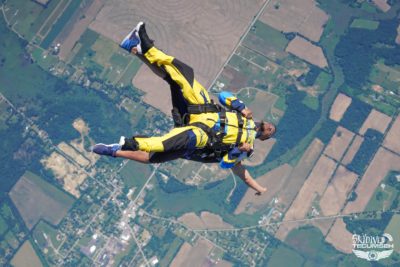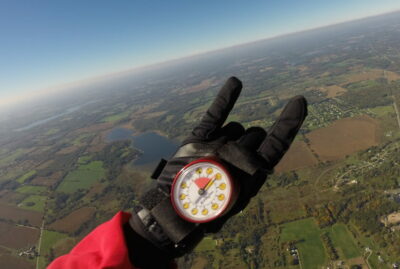- Michigan's Premier Skydiving Center
- Call Now: (517) 423-7720
How Do Skydivers Know When to Open Parachute?
Friday, March 31, 2023
- Skydive Tecumseh
- 3/31/23
- 0
- Blog
A lot goes into making every skydive. Planning, equipment, skill, and knowledge. Even other people. So how do skydivers know when to open their parachutes? Luckily, there are various pieces of equipment that help with this very important task. Whether it’s analog or digital, on their wrist or in their helmet, skydivers have plenty of technical assistance with determining their altitude throughout a jump.
 But here’s the even bigger question: at what height do skydivers open their parachutes? Generally speaking, skydivers open their parachutes between 3,000 feet and 5,000 feet. But certain disciplines call for different opening altitudes. Students, tandems, and canopy pilots all have different needs. And whatever type of altimeter (i.e. altitude meter) each skydiver chooses to use will tell them exactly when their altitude is up.
But here’s the even bigger question: at what height do skydivers open their parachutes? Generally speaking, skydivers open their parachutes between 3,000 feet and 5,000 feet. But certain disciplines call for different opening altitudes. Students, tandems, and canopy pilots all have different needs. And whatever type of altimeter (i.e. altitude meter) each skydiver chooses to use will tell them exactly when their altitude is up.
Here are some techniques and technology that help skydivers determine when it’s time to deploy their canopies.
Planning the Jump
One of the most important parts of a skydive actually happens on the ground. There are a lot of different situational and environmental factors to consider with every jump. What is the wind doing? How many people are on the jump? What are all the different groups on the airplane doing on their jumps? These questions, and more, need to be answered before anyone gets into (and especially out of) the airplane.
These factors also help skydivers decide when they will open their parachutes. Most importantly, everyone on the plane needs to know when each skydiver is going to open their parachute so that a plan can be made to create enough distance to avoid collisions.
What happens if you open your parachute too early? On an individual level, that isn’t much of an issue. You’ll just have a longer ride to the ground! But it’s important to watch out for the skydivers who exited after you. They won’t be expecting a parachute to be in the air so high up, and that could cause the potential for collisions.
Visual Altimeters
 Visual altimeters are the most common way that skydivers measure their altitude during a skydive. These types of altimeters are worn on the wrist or hand and typically measure the distance to the ground in thousands of feet.
Visual altimeters are the most common way that skydivers measure their altitude during a skydive. These types of altimeters are worn on the wrist or hand and typically measure the distance to the ground in thousands of feet.
The original type of visual altimeter is analog. This type of altimeter looks a lot like the face of a clock, complete with 12 numbers and a dial. The face goes from 0 to 11, each number indicating 1,000 feet and the zero also representing 12,000. If the jump is being made from above 12,000 feet, the dial will go around a second time. Analog altimeters use barometric pressure to measure altitude and move the dial accordingly. Pretty neat, right?
As skydiving equipment progressed, digital visual altimeters started to show up on the scene. This version of the visual altimeter works through barometric pressure the same way the analog does, but the display is quite different. Sticking with the clock analogy, a digital altimeter would be like a digital watch. The face of a digital altimeter displays the altitude in full and decimal numbers, with the full number representing thousands of feet and the decimal being hundreds.
The choice between analog and digital comes down to individual skydiver preferences. They work the same – it’s all about what each person finds easier to read.
Audible Altimeters
Audible altimeters are also a result of advanced digital technology. This nifty device fits comfortably inside a skydiver’s helmet right near their ear.
There are a series of alarms available on audible altimeters that can go off at any altitude the jumper selects. This provides an extra layer of altitude awareness by beeping in the skydiver’s ear at the preset altitudes. This way, if a skydiver forgets to look at their visual altimeter or can’t see it for any reason, their audible will still alert them when they’ve reached opening altitude. Some audibles can even be set to alert the skydiver of important landing altitudes while under their parachute!
Pro tip: Want a peek into some skydiver lingo? Audible altimeters are often referred to as Dytters.
Safety Net
So, what happens if a skydiver isn’t paying attention to their altitude and it’s time to open their parachute? Does a parachute open automatically in skydiving? There actually is a piece of equipment that will automatically open the reserve parachute in case the skydiver doesn’t, or can’t.
This lifesaving piece of equipment is called an AAD, or Automatic Activation Device. An AAD is a small computer that sits inside the reserve parachute tray and measures a skydiver’s altitude and speed. If a skydiver is going too fast, or too low, the AAD will automatically deploy the reserve parachute before the skydiver impacts the ground.
The AAD is meant to be used as a last resort and should not be counted on as part of regular skydiving procedures. But it’s certainly nice to know that even when skydivers don’t know their altitude, their equipment does!
We can’t wait to show you how much fun you can have at all different altitudes! Come skydive with us today!

Wonderful staff -- my tandem instructor, James, was funny, clear, and made sure that I was comfortable during the entire experience (which involved two flights and a bit of "will-we-or-won't-we" due to clouds).
The dive itself is unreal -- exhilarating and meditative, terrifying and relaxing, absolutely breathtaking. I absolutely recommend you try it here first. Skydive Tecumseh has a great reputation, and there's a reason for that. I hope to go again.
John Maguire
Copyright © 2025, Skydive Tecumseh, All Rights Reserved.
DropZone Web Design & Marketing by Beyond Marketing, LLC